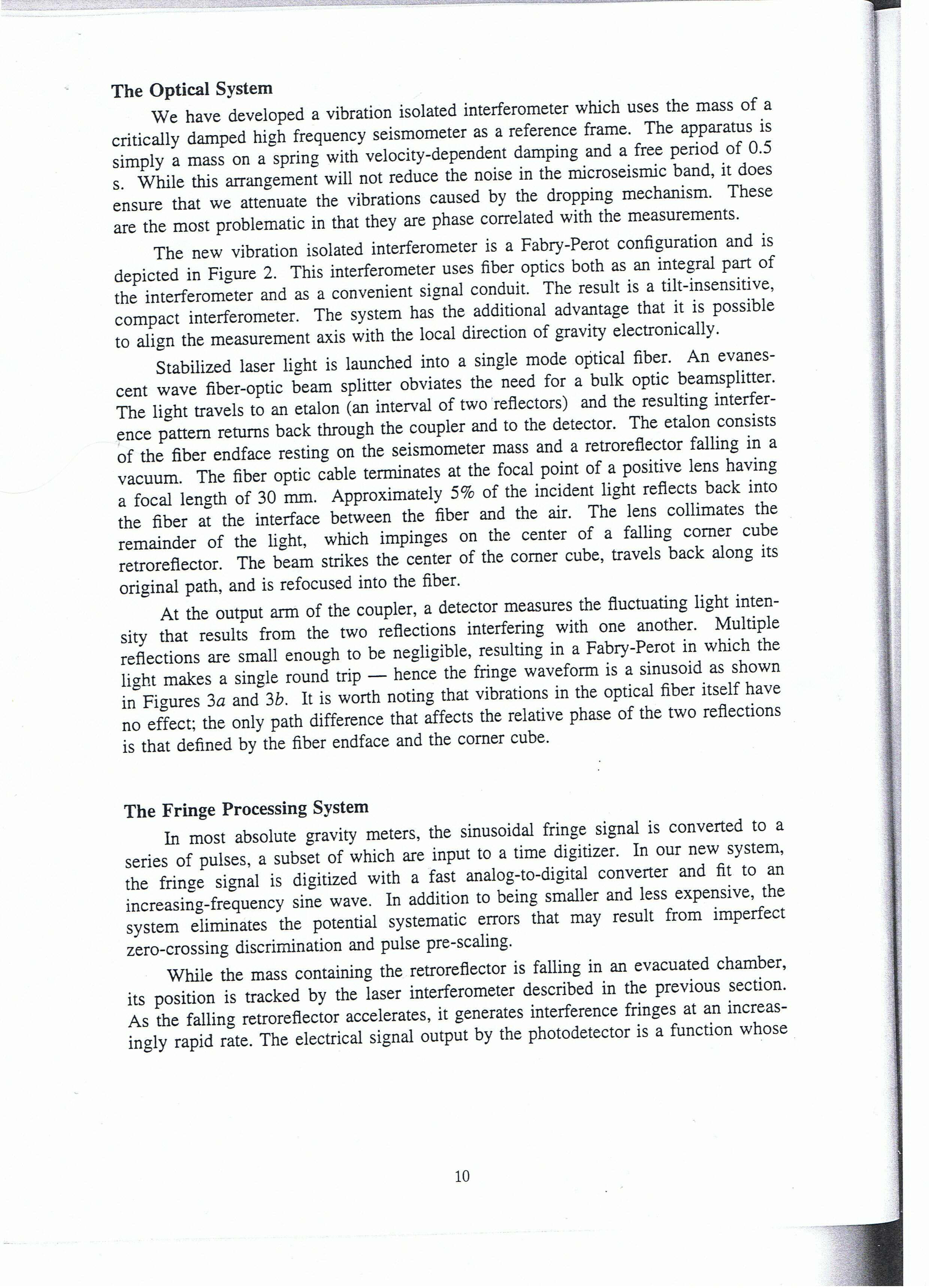CCF20100310�005

The Optical System
We have developed a vibration isolated interferometer which uses the mass of a critically damped high freąuency seismometer as a reference frame. The apparatus is simply a mass on a spring with velocity-dependent damping and a free period of 0.5 s. While this arrangement will not reduce the noise in the microseismic band, it does ensure that we attenuate the vibrations caused by the dropping mechanism. These are the most problematic in that they are phase correlated with the measurements.
The new vibration isolated interferometer is a Fabry-Perot configuration and is depicted in Figurę 2. This interferometer uses fiber optics both as an integral part of the interferometer and as a convenient signal conduit. The result is a tilt-insensitive, compact interferometer. The system has the additional advantage that it is possible to align the measurement axis with the local direction of gravity electronically.
Stabilized laser light is launched into a single modę optical fiber. An evanes-cent wave fiber-optic beam splitter obviates the need for a bulk optic beamsplitter. The light travels to an etalon (an interwal of two reflectors) and the resulting interfer-ence pattem retums back through the coupler and to the detector. The etalon consists of the fiber endface resting on the seismometer mass and a retrorefiector falling in a vacuum. The fiber optic cable terminates at the focal point of a positive lens having a focal length of 30 mm. Approximately 5% of the incident light refiects back into the fiber at the interface between the fiber and the air. The lens collimates the remainder of the light, which impinges on the center of a falling comer cube retrorefiector. The beam strikes the center of the comer cube, travels back along its original path, and is refocused into the fiber.
At the output arm of the coupler, a detector measures the fluctuating light inten-sity that results from the two reflections interfering with one another. Multiple refiections are smali enough to be negligible, resulting in a Fabry-Perot in which the light makes a single round trip — hence the fringe waveform is a sinusoid as shown in Figures 3a and 3b. It is worth noting that vibrations in the optical fiber itself have no effect; the only path difference that affects the relative phase of the two reflections is that defined by the fiber endface and the comer cube.
The Fringe Processing System
In most absolute gravity meters, the sinusoidal fringe signal is converted to a series of pulses, a subset of which are input to a time digitizer. In our new system, the fringe signal is digitized with a fast analog-to-digital converter and fit to an increasing-freąuency sine wave. In addition to being smaller and less expensive, the system eliminates the potential systematic errors that may result from imperfect zero-crossing discrimination and pulse pre-scaling.
While the mass containing the retrorefiector is falling in an evacuated chamber, its position is tracked by the laser interferometer described in the previous section. As the falling retrorefiector accelerates, it generates interference fringes at an increas-ingly rapid ratę. The electrical signal output by the photodetector is a function whose

1
10
Wyszukiwarka
Podobne podstrony:
CCF20100216�000 2 The production of speech sounds 2.1 Articulators above the larynx Ali the sounds w
CCF20100216�000 2 The production of speech sounds 2.1 Articulators above the larynx Ali the sounds w
CCF20100216�005 2 The production of speech sounds 13 Cardinal vowel no. 1 has the symbol [i], and is
CCF20100216�007 2 The production of speech sounds 15 een primary and secondary Cardinal vowels is a
CCF20101202�002 THE PRONUNCIATION OF THE SENTENCE, lb (from RK) WITH RHYTHM AND INTONATON ANALYSE AN
CCF20110611�025 the light of the qua!ity of learning outcomes and vice versa. This kind of joint ref
CCF20100216�001 The production of speech sounds 9 part being the back of the orał cavity and the oth
CCF20101201�000 The Church of The Holy Trynity at the Lublin’s Castle Summary The Church of The Holy
CCF20100216�005 2 The production of speech sounds 13 Cardinal vowel no. 1 has the symbol [i], and is
CCF20100216�007 2 The production of speech sounds 15 een primary and secondary Cardinal vowels is a
22020 mbs 037 MY BREATHING SYSTEM Finally, we have the horizontal backward cpansion, forming the six
30 (454) 54 The Viking Age in Denmark touch, so the political developmcnt we have described in previ
ed and to institutions that have been developed. The conservation of the existing system must not be
IMGx48 268 The Origin of Civilisatiou Armed with the theoretical base we have now built, this concep
więcej podobnych podstron